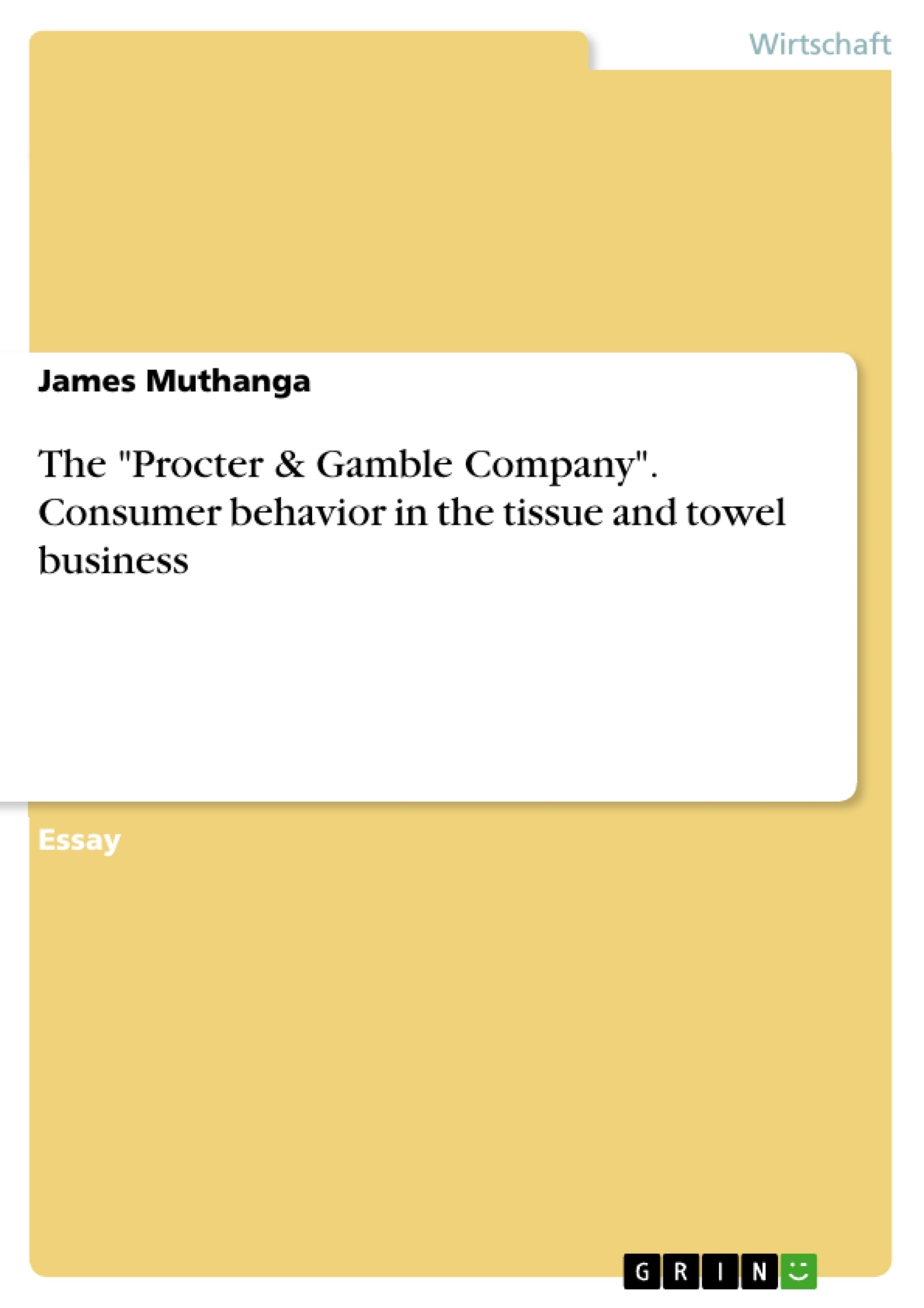The objective of this report is to provide a clear understanding of relevant consumer behavior in the tissue/towel business inclusive of any additional relevant information about consumer behavior. The report will further offer other market research methods that can be used to in addition to the one in the situation provided. Eventually, the report will provide a SWOT analysis, inclusive of the set SMART objectives for the tissue/towel business.
The Procter & Gamble Company was established in in the year 1837 with the aim of producing and distributing paper products such as pampers, tissue paper, bathroom tissue. Its formation occurred when two immigrant candle and soap makers decided to form a partnership. The Procter & Gamble Company became a corporation in 1890, and since then it managed to expand and double its sells in U.S. market. The success of P&G Company can be attributed to its undisputable reputation for strong marketing, conservative management, high-quality products and high integrity.
The company managed to exhibit successful expansion through acquisition of major companies both locally and internationally. The proprietor technology, use of total quality methods, value-added products, high media weight inclusive of successful advertising themes were used the key strategies to gain competitive advantage and obtain a substantial market share for its products. The initial stage to initiate an expansion occurred in 1991 when it was clear that Charmin, Bounty, and Puffs had succeeded in obtaining a significant market share in the US. P&G thus decided to acquire Facelle Co. which deal with bathroom tissue, paper towels and facial tissue inclusive of the Royale, Florelle, Pronto, Dove, Facettes, and Festival brands.
From the Procter & Gamble: Facelle Division Tissue case study, it can be deduced that absence of strategies for global collaboration, lack of or insufficient innovation and technology, transportation cost and sophisticated communication channels are the key challenges facing many companies. Recommendations for a better environment to conduct business include clear communication, access to innovation and technology, an improvement in performance and reliable return on investment.
Inhaltsverzeichnis
- Executive Summary
- Introduction
- Consumer Behavior in the Tissue/Towel Business
- Advertising, Consumer Promotion, and Pricing
- Understanding Consumer Behavior in Tissue and Towel Business
- Influence of Promotions and Advertisements
- Millennials and Hygiene
- Delivery Cost and Consumer Behavior
- Competitor Analysis Research Procter & Gamble
- PESTLE
- Market segmentation
- Positioning
- Product life cycle (PLC)
Zielsetzung und Themenschwerpunkte
Der Bericht zielt darauf ab, ein umfassendes Verständnis des Verbraucherverhaltens in der Tissue-/Handtuchbranche zu vermitteln, einschließlich relevanter Informationen zu Verbraucherpräferenzen und -verhalten. Der Bericht wird außerdem zusätzliche Marktforschungsmethoden untersuchen und eine SWOT-Analyse durchführen, einschließlich SMART-Zielen für das Tissue-/Handtuchgeschäft.
- Verbraucherverhalten in der Tissue-/Handtuchbranche
- Wettbewerbsanalyse von Procter & Gamble
- Marktsegmentierung und Positionierung
- Produkt-Lebenszyklus (PLC)
- PESTLE-Analyse
Zusammenfassung der Kapitel
Der Bericht beginnt mit einer Einleitung, die das Konzept des Verbraucherverhaltens definiert und die Ziele des Berichts darlegt. Anschliessend untersucht das Kapitel „Consumer Behavior in the Tissue/Towel Business“ die Faktoren, die das Verbraucherverhalten in dieser Branche beeinflussen, wie z. B. Werbung, Konsumentenförderung und Preisgestaltung. Es werden auch die Auswirkungen von Promotions und Werbung auf das Verbraucherverhalten analysiert, sowie der Einfluss der modernen Konsumentengeneration (Millennials) auf den Hygienemarkt. Das Kapitel erörtert auch die Rolle der Lieferkosten bei der Beeinflussung des Verbraucherverhaltens.
Das Kapitel „Competitor Analysis Research Procter & Gamble“ befasst sich mit der Identifizierung von Wettbewerbern, der Bewertung ihrer Strategien und der Analyse ihrer Stärken und Schwächen. Der Bericht untersucht dann das PESTLE-Framework, ein Instrument zur Analyse des externen Umfelds eines Unternehmens. Die Kapitel „Market Segmentation“ und „Positioning“ befassen sich mit der Marktsegmentierung, der Positionierung von Produkten im Bewusstsein der Verbraucher und der Bedeutung einer starken Markenpositionierung.
Schliesslich beschreibt das Kapitel „Product life cycle (PLC)“ das Konzept des Produktlebenszyklus, der die verschiedenen Phasen eines Produkts vom Marktstart bis zum Marktaustritt beschreibt. Der Bericht erläutert die Bedeutung des PLC-Konzepts für Unternehmen, um fundierte Marketingentscheidungen zu treffen.
Schlüsselwörter
Die wichtigsten Schlüsselwörter des Berichts sind Verbraucherverhalten, Tissue-/Handtuchbranche, Wettbewerbsanalyse, Marktsegmentierung, Positionierung, Produkt-Lebenszyklus, PESTLE-Analyse, Procter & Gamble.
- Quote paper
- James Muthanga (Author), 2017, The "Procter & Gamble Company". Consumer behavior in the tissue and towel business, Munich, GRIN Verlag, https://www.grin.com/document/388556




